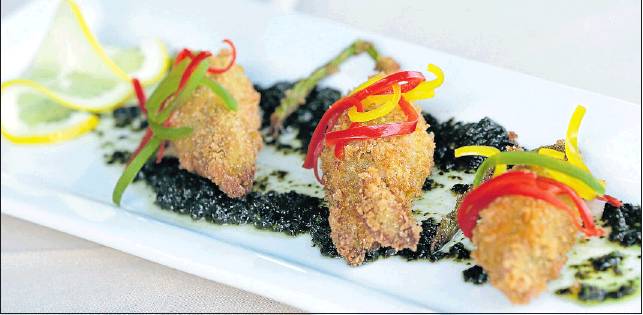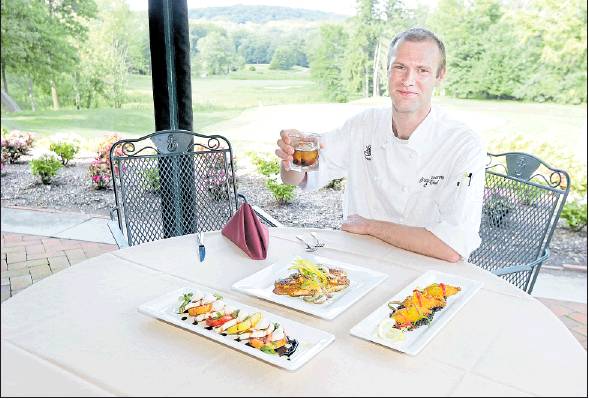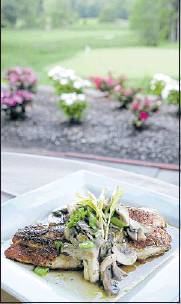Golfers going for healthier eating at local clubs
By Allison Steele STAFF WRITERServers at the Bala Golf Club on Belmont Avenue were the first to see the change coming. It started with a few members asking to have their food cooked with olive oil instead of butter. Then it was requests for more fish specials.
Earlier this year, when Michael Fox was promoted from front-of-house staff and took over the kitchen as executive chef, his first order of business was to make changes to the clubhouse menu. By then, he’d been hearing requests for years from diners who wanted the kitchen to make healthy adjustments to the menu.
“We still have those people who like their food drenched in butter, but fewer all the time,” said food and beverage manager Ryan Fitzpatrick. “It’s really become a much more health-conscious clientele.”
Managers of dining rooms and clubhouses around the region say that more golfers are moving away from steak-and-potato entrees and making healthier choices when they come off the greens. And as with restaurants and even fast-casual eateries, chefs have also had to meet a growing demand for local and seasonable food.
At the Lookaway Golf Club, a 268-member private course in Buckingham, tomatoes and herbs are grown on site to add to salads, and chef Kevin Blalock sources enough fish to offer two to three specials each week, such as red snapper with wild mushrooms.
“It’s probably the item that gets ordered the most,” he said of the rotating fish specials. He also noticed that players wanted to eat less overall, so the club started offering half-portions for some meals.
The majority of Look-away’s members are equity owners and pay $52,000 to get in, followed by annual fees of $10,000 for individuals. Given that, they expect to be able to order whatever they want when they bring their families for dinner, Blalock said. And because many members are built-in regular customers, many of them want to try something new each time.
“We can’t get complacent,” Blalock said, “because they’ll always be back.”
Lookaway has experimented with Vietnamese pho nights, tapas, soft-shell crabs, even fresh king crab shipped from Alaska. In response to customer demand, they started making gluten-free desserts, and have found that the more they offer, the more gets eaten.
And bread has never been less popular, sous chef Brian Devenny said. “If we have 100 members at dinner, we can put out 35 dinner rolls and that’s enough,” he said.
Earlier this year, when Fox took over as chef at the Bala club, he downsized en-tree portions and made small tweaks, such as serving seafood with sauces other than drawn butter. One of the biggest-selling items last summer was a steamer basket of branzino and seasonal vegetables in rice wine vinegar.
“There’s a lot we can do,” Fitzpatrick said. “If someone doesn’t want something with barbecue or teriyaki sauce, we can grill it with just olive oil and lemon.”
Burgers and flatbreads are still wildly popular for golfers coming off the greens. But now so is the half-size sandwich option, Fitzpatrick said.
Though the U.S. golfing industry has struggled with declining numbers in recent years, a report last year by the National Golf Foundation found that first-time players are on the rise. Many clubs now look to draw in younger members by offering “young executive” memberships with lower fees for under-40 players.
At the Greate Bay Country Club in Somers Point, N.J., a recent influx of under-40 members has revitalized the club, general manager Ron Ralston said.
“The running joke is, the shop runs out of medium shirts,” he said. “They’re all skinny!”
Generally, market research has found that younger consumers are more health conscious. But Ralston said he hasn’t necessarily seen those members exhibit better eating habits.
“They still like their wings and beer,” he said. “The women, on the other hand — they’re clearly more health conscious. They like to eat light. For them it’s fruit, wraps, shrimp salads. We do a lot of fresh salads with farro, quinoa. The ladies eat ‘em; the men don’t.”
Located less than five miles from Ocean City and close to other Shore towns, Greate Bay is actually a summer club for many of its 1,000 members, a number of whom belong to year-round clubs closer to where they live, Ralston said. Perhaps that leads to more of a vacation mindset for golfers when they come off the links, he said.
Generally, though, members are eating smaller portions and less meat, chef Richard Salerno said.
“You put a pork chop on the menu, it’s just not selling like it used to,” he said. “They’ll go with a six-ounce filet instead of a 12-ounce. They’ll have a petit filet with a crab cake. They’ll say, ‘What’s the fresh fish tonight?’” asteele@phillynews.com
215-854-4543
@AESteele



